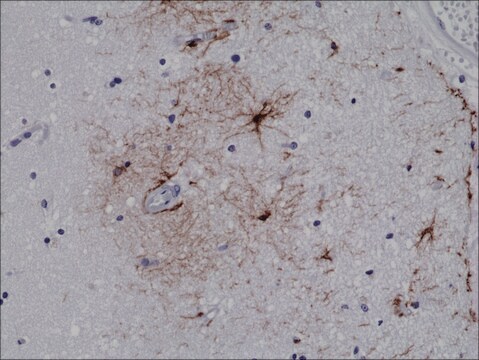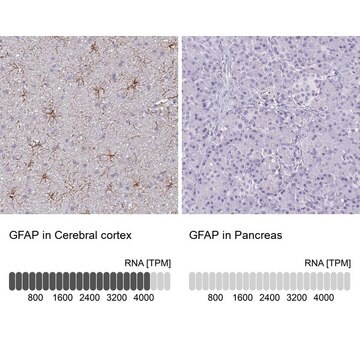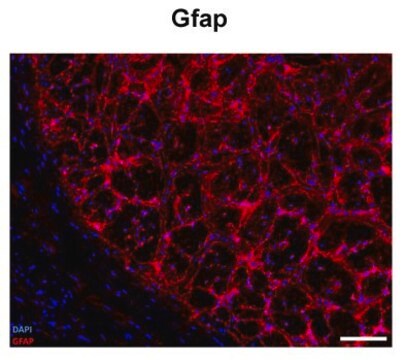SAB5500113
Anti-GFAP antibody, Rabbit monoclonal
recombinant, expressed in proprietary host, clone SP78, affinity isolated antibody
Anmeldenzur Ansicht organisationsspezifischer und vertraglich vereinbarter Preise
Alle Fotos(1)
About This Item
UNSPSC-Code:
12352203
NACRES:
NA.41
Empfohlene Produkte
Biologische Quelle
rabbit
Qualitätsniveau
Rekombinant
expressed in proprietary host
Konjugat
unconjugated
Antikörperform
affinity isolated antibody
Antikörper-Produkttyp
primary antibodies
Klon
SP78, monoclonal
Speziesreaktivität
human (tested)
Speziesreaktivität (Voraussage durch Homologie)
mouse, bovine, dog, rabbit, pig, rat
Methode(n)
immunohistochemistry: 1:100
Isotyp
IgG
UniProt-Hinterlegungsnummer
Versandbedingung
wet ice
Lagertemp.
2-8°C
Posttranslationale Modifikation Target
unmodified
Angaben zum Gen
human ... GFAP(2670)
Allgemeine Beschreibung
Glial fibrillary acidic protein (GFAP) is a member of the class III intermediate filament protein family. It is heavily, and specifically, expressed in astrocytes and certain other astroglia in the central nervous system, in satellite cells in peripheral ganglia, and in non myelinating Schwann cells in peripheral nerves. In addition, neural stem cells frequently strongly express GFAP. Antibodies to GFAP are therefore very useful as markers of astrocytic cells. In addition, many types of brain tumors presumably derived from astrocytic cells, heavily express GFAP. GFAP is also found in the lens epithelium, Kupffer cells of the liver, in some cells in salivary tumors and has been reported in erythrocytes. GFAP is particular expressed in auricular chondrocytes.
Immunogen
Synthetic peptide corresponding to C-terminus of human GFAP protein.
Anwendung
Anti-GFAP antibody, Rabbit monoclonal has been used in immunocytochemistry and Immunohistochemistry.
Biochem./physiol. Wirkung
Glial fibrillary acidic protein (GFAP) maintains the structure and motility of astrocytes. Gfap mediates the interaction between neurons and glial cells. It is responsible for the integrity and function of blood-brain barrier. Myelination and brain injury induced astrogliosis is controlled by Gfap. Cytoskeleton disintegration is known to stimulate the release of Gfap. Upregulation of this gene is observed in traumatic brain injury such as intracerebral hemorrhage and thus serves as a biomarker. Mutation in the GFAP gene causes Alexander disease.
Leistungsmerkmale und Vorteile
Evaluate our antibodies with complete peace of mind. If the antibody does not perform in your application, we will issue a full credit or replacement antibody. Learn more.
Physikalische Form
0.1 ml rabbit monoclonal antibody purified by protein A/G in PBS/1% BSA buffer pH 7.6 with less than 0.1% sodium azide.
Haftungsausschluss
Unless otherwise stated in our catalog or other company documentation accompanying the product(s), our products are intended for research use only and are not to be used for any other purpose, which includes but is not limited to, unauthorized commercial uses, in vitro diagnostic uses, ex vivo or in vivo therapeutic uses or any type of consumption or application to humans or animals.
Sie haben nicht das passende Produkt gefunden?
Probieren Sie unser Produkt-Auswahlhilfe. aus.
Lagerklassenschlüssel
10 - Combustible liquids
WGK
WGK 2
Flammpunkt (°F)
Not applicable
Flammpunkt (°C)
Not applicable
Hier finden Sie alle aktuellen Versionen:
Besitzen Sie dieses Produkt bereits?
In der Dokumentenbibliothek finden Sie die Dokumentation zu den Produkten, die Sie kürzlich erworben haben.
Increases of Plasma Levels of Glial Fibrillary Acidic Protein, Tau, and Amyloid β up to 90 Days after Traumatic Brain Injury.
Tanya B, et al.
Journal of Neurotrauma, 34(1), 66?73-66?73 (2017)
The predominant neural stem cell isolated from postnatal and adult forebrain but not early embryonic forebrain expresses GFAP.
Imura T, et al.
The Journal of Neuroscience, 23(7), 2824-2832 (2003)
Qiang Zhang et al.
The European journal of neuroscience, 46(9), 2507-2518 (2017-09-19)
Injury to the adult central nervous system (CNS) results in the formation of glial scar tissues. Glial scar-induced failure of regenerative axon pathfinding may limit axon regrowth beyond the lesion site and cause incorrect reinnervation and dystrophic appearance of stalled
Time-dependent activity of Na+/H+ exchanger isoform 1 and homeostasis of intracellular pH in astrocytes exposed to CoCl2 treatment.
Wang P, et al.
Molecular Medicine Reports, 13(5), 4443-4450 (2016)
HIV-1 Tat Induces Unfolded Protein Response and Endoplasmic Reticulum Stress in Astrocytes and Causes Neurotoxicity through Glial Fibrillary Acidic Protein (GFAP) Activation and Aggregation.
Yan F and Johnny J H
The Journal of Biological Chemistry, 291(43), 22819- 22829 (2016)
Unser Team von Wissenschaftlern verfügt über Erfahrung in allen Forschungsbereichen einschließlich Life Science, Materialwissenschaften, chemischer Synthese, Chromatographie, Analytik und vielen mehr..
Setzen Sie sich mit dem technischen Dienst in Verbindung.




